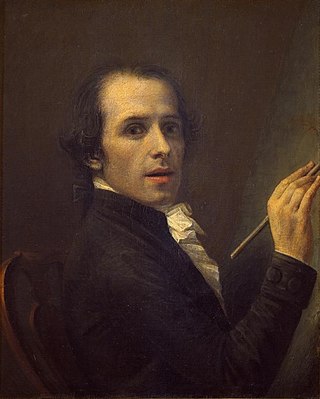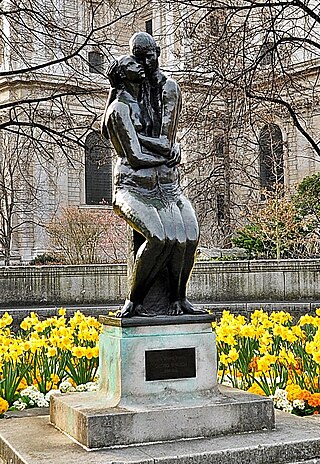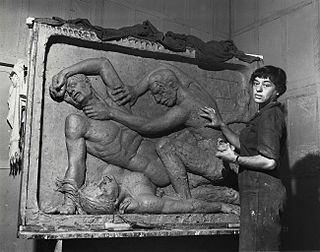
Antonio Canova was an Italian Neoclassical sculptor, famous for his marble sculptures. Often regarded as the greatest of the Neoclassical artists, his sculpture was inspired by the Baroque and the classical revival, and has been characterised as having avoided the melodramatics of the former, and the cold artificiality of the latter.

In Greek mythology, Daedalus was a skillful architect and craftsman, seen as a symbol of wisdom, knowledge and power. He is the father of Icarus, the uncle of Perdix, and possibly also the father of Iapyx. Among his most famous creations are the wooden cow for Pasiphaë, the Labyrinth for King Minos of Crete which imprisoned the Minotaur, and wings that he and his son Icarus used to attempt to escape Crete. It was during this escape that Icarus did not heed his father's warnings and flew too close to the sun; the wax holding his wings together melted and Icarus fell to his death.
Icarus is a character in Greek mythology.

In Greek mythology, Icarus was the son of the master craftsman Daedalus, the architect of the labyrinth of Crete. After Theseus, king of Athens and enemy of Minos, escaped from the labyrinth, King Minos suspected that Icarus and Daedalus had revealed the labyrinth's secrets and imprisoned them—either in a large tower overlooking the ocean or the labyrinth itself, depending upon the account. Icarus and Daedalus escaped using wings Daedalus constructed from feathers, threads from blankets, clothes, and beeswax. Daedalus warned Icarus first of complacency and then of hubris, instructing him to fly neither too low nor too high, lest the sea's dampness clog his wings or the sun's heat melt them. Icarus ignored Daedalus's instructions not to fly too close to the sun, causing the beeswax in his wings to melt. Icarus fell from the sky, plunged into the sea, and drowned. The myth gave rise to the idiom, "fly too close to the sun." In some versions of the tale, Daedalus and Icarus escape by ship.
Events from the year 1973 in art.

Frederic Leighton, 1st Baron Leighton,, known as Sir Frederic Leighton between 1878 and 1896, was a British Victorian painter, draughtsman, and sculptor. His works depicted historical, biblical, and classical subject matter in an academic style. His paintings were enormously popular and expensive, during his lifetime, but fell out of critical favour for many decades in the early 20th century.

Michael Ayrton was a British painter, printmaker, sculptor, critic, broadcaster and novelist. His sculptures, illustrations, poems and stories often focused on the subjects of flight, myths, mirrors and mazes.
Nikos Hadjikyriakos-Ghikas, also known as Nikos Ghika, was a leading Greek painter, sculptor, engraver, writer and academic. He was a founding member of the Association of Greek Art Critics, AICA-Hellas, International Association of Art Critics.
Peter Forakis was an American artist and professor. He was known as an abstract geometric sculptor.

Tekniska högskolan is a station on the red line of the Stockholm metro, located in the districts Östermalm and Norra Djurgården, near the Royal Institute of Technology. The station was opened on 30 September 1973 as the northern terminus of the extension from Östermalmstorg. On 12 January 1975, the line was extended further north to Universitetet. Tekniska högskolan metro station is connected to Stockholm East Station or Stockholms östra, a station on the Roslagsbanan railway, and a terminal for buses towards Norrtälje and Vaxholm.

Cambridge Guildhall is a civic building in the centre of the historic city of Cambridge, England. It includes two halls, The Large Hall and The Small Hall, and is used for many disparate events such as comedy acts, conferences, craft fairs, live music, talks, and weddings. It is also used by the University of Cambridge for certain examinations. It is owned and managed by the Cambridge City Council, and it is their seat of government. The Guildhall is located on the south side of Market Hill, the market square in Cambridge, between Peas Hill to the west and Guildhall Street to the east. It is a Grade II listed building.

The Lament for Icarus is a painting by Herbert James Draper, showing the dead Icarus, surrounded by lamenting nymphs. The wings of Icarus are based on the bird-of-paradise pattern. In 1898, the painting was bought from the Royal Academy exhibition through The Chantrey Bequest, a public fund for purchasing modern art bequeathed by Sir Francis Leggatt Chantrey, R.A. The Lament for Icarus was subsequently awarded the gold medal at the Exposition Universelle of 1900 in Paris.

Jardim São Paulo–Ayrton Senna, originally known only as Jardim São Paulo, is a metro station on São Paulo Metro Line 1-Blue, located in the district of Santana, in São Paulo. It was opened by Governor Mário Covas on 29 April 1998, along with stations Tucuruvi and Parada Inglesa, in the Line 1 north expansion project, initiated in 1996.

Parthian art was Iranian art made during the Parthian Empire from 247 BC to 224 AD, based in the Near East. It has a mixture of Persian and Hellenistic influences. For some time after the period of the Parthian Empire, art in its styles continued for some time. A typical feature of Parthian art is the frontality of the people shown. Even in narrative representations, the actors do not look at the object of their action, but at the viewer. These are features that anticipate the art of medieval Europe and Byzantium.

The Young Lovers is an outdoor sculpture by Georg Ehrlich, installed at Festival Gardens in London, United Kingdom. It was installed in the garden in 1973.

Hélène Sardeau was an American sculptor, born in Antwerp, Belgium, who moved with her family to the United States when she was about 14 years old.

The Fall of Icarus is a 1958 mural by Pablo Picasso. Made of 40 painted mahogany tiles covering 90m2, it is the artist's largest work. It was commissioned by UNESCO for the organisation's main foyer in Paris and was unveiled on 29 March 1958.

Maurice Prosper Lambert RA was a British sculptor. He was the son of the artist George Washington Lambert and the older brother of the composer and author Constant Lambert.
Born in South Africa, Michael Edward Bolus was an artist and teacher who settled in England in 1957 and studied at St Martin's School of Art from 1958 to 1962, studying under Anthony Caro. After a brief period living in Cape Town he returned to London in 1964 to begin a teaching post at St Martin's and the Central School of Art and Design. Bolus had his first UK solo exhibition at Waddington Galleries in 1968, which has exhibited a number of his sculptures since then.

The Arkville Maze is a private maze commissioned by businessman Armand G. Erpf and designed by Michael Ayrton, being constructed at Erpf's estate in Arkville, New York in 1969.
















